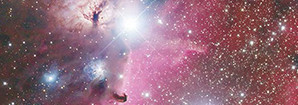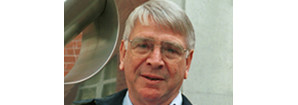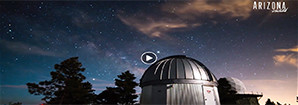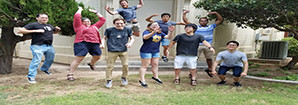Spotlight

Astrophoto Videos from Adam Block
Astrophotographer Adam Block of Steward Observatory has produced two videos using the Pomenis 180mm astrograph for wide-field imaging and the Mt Lemmon Sky Center telescopes for the higher-resolution imaging. The first video, HERE, is of the region of the constellation of Orion. The second, HERE, is of the region of the constellation Serpens. You can see more images HERE. The movies, images and cover photo here are all courtesy/copyright Adam Block.

Applications Being Accepted for Strittmatter Fellowship
The University of Arizona Dept of Astronomy and Steward Observatory is seeking applicants for the Peter A Strittmatter Fellowship for Advanced Study in Astronomy & Astrophysics. The job ad can be found HERE. For more information, please contact Professor Feryal Ozel (fozel) or Dr. Jared Males (jrmales). (Add "@email.arizona.edu" to the prefix in the previous sentence.)

Assistant Professor Peter Behroozi Wins Packard Fellowship
We are pleased to announce that Assistant Professor Peter Behroozi is part of a nationwide class of 22 early-career scientists to be awarded a Packard Fellowship. He is one of only four astronomers to get this five-year, $875000 award in 2019. You can read about the Packard HERE and Daniel Stolte's UANews story HERE.
Part of Peter's research will be to try to understand how supermassive black holes form so quickly in the early universe. Observations by others have shown that by the time the universe is 700 million years old (5% of its current age), there already exist supermassive black holes large enough to power the most luminous quasars. Current physical models simply cannot make such large black holes on the timescales that Nature does. Peter and his graduate student, Haowen Zhang, will attack this problem in the following way: "We are going to use our experience in creating millions of virtual universes containing billions of galaxies and apply it to generating new synthetic universes, this time filled with black holes," Peter says. "We will then compare our results to observational data of active, supermassive black holes and quasars at different times as well as to black holes closer to home."
Please join us in congratulating Peter. Peter joins Astronomy/Steward Professors Dennis Zaritsky (1997) and Xiaohui Fan (2004) as Packard winners.

Arizona Illustrated and Telumundo Visit Mt Lemmon Sky Center
In October Arizona Illustrated visited the Mount Lemmon Sky Center and did a feature on the public observing done there. You can see the video HERE. In addition, a similar spot was filmed during summer shutdown 2019, in Spanish, and shown on Telemundo.
(The photo is a screenshot from the Arizona Illustrated video.)

2019-2020 First-Year Grad Students
Another academic year has begun. Here are two photos of our first-year class. Photo 1 is the formal photo and Photo 2 is the proof that our students can fly.
From left to right: Quentin Socia, Logan Pearce, Cameron White, Spencer Scott, Victoria Jones, Jiachuan Xu, Justin Kang, Pranjal Rajendra Singh and Zuyi Chen.
(Photos are courtesy Michelle Cournoyer.)

The SAGUARO Project and Multi-Messenger Astronomy
Since April 2019 , Michael Lundquist and David Sand of Steward Observatory along with a team of astronomers from Northwestern University have partnered with Eric Christensen (LPL) and the Catalina Sky Survey (CSS) on the Searches After Gravitational-waves using ARizona Observatories (SAGUARO) project. This project uses the Steward Observatory Mount Lemmon 60” telescope to search for optical counterparts to gravitational wave events using the CSS asteroid survey. CSS provides two years worth of historical imaging that is used with image subtraction to more easily identify new events. Many in the Steward community are involved, with the team, in the follow-up observations of these events.
In April 2019 the Advanced LIGO and Virgo facilities turned on and began their third observing run looking for the gravitational wave signals indicative of the mergers of compact objects such as neutron stars and black holes. While no optical counterparts to the gravitational wave event were found, by anyone in the world, the SAGUARO team was able to test and improve its telescope response to the LIGO alerts. In this test, it discovered two new supernovae (unrelated to detected gravitational waves) and utilized the Large Binocular Telescope Observatory to spectroscopically classify one promising optical counterpart from another group. This object, PS19eq, was also determined to be a supernova and unfortunately not a kilonova.
To date, only one optical counterpart to a gravitational wave event, AT2017gfo, has been found. Part of the reason for this is that the gravitational wave observatories can only localize events to tens or hundreds (or even thousands) of square degrees.The image shows the gravitational wave localization of this object as well as field centers of observed images. Teams such as SAGUARO are able to image many square degrees of sky quickly, looking for things that have changed brightness, and then to use large telescopes for spectroscopic followup of the most likely transient sources.
This is a new and exciting field that will open up our understanding of heavy element production in the universe, provide independent measurements of cosmological parameters, and provide clues to the structure of neutron stars. The current LIGO and Virgo observing run continues through April 2020. SAGUARO represents the one of the most significant additions to the search for optical counterparts. The SAGUARO team is ready and able to follow up these detections searching for the elusive optical counterparts.
You can read the Saguaro paper HERE. The UA News article is HERE.
Pages

For Public
Public events include our Monday Night Lecture Series, world-reknowned Astronomy Camp and Mt Lemmon Sky Center.

For Students
A good place to start if you want to become an undergrad major or grad student, or need to find our schedule of classes.

For Scientists
Find telescopes and instruments, telescope time applications, staff and mountain contacts, and faculty and staff scientific interests.




